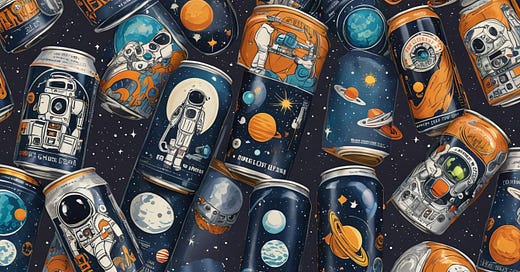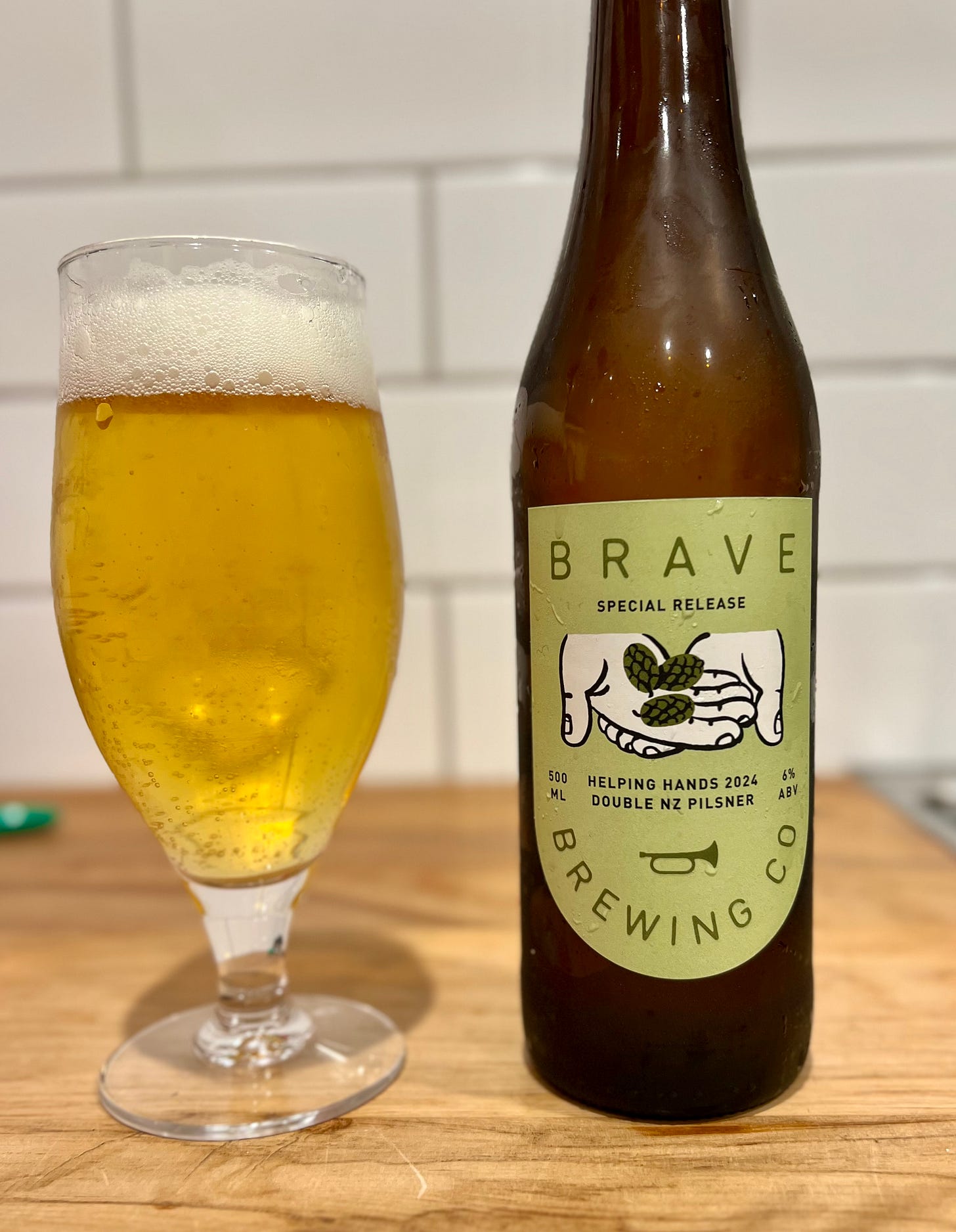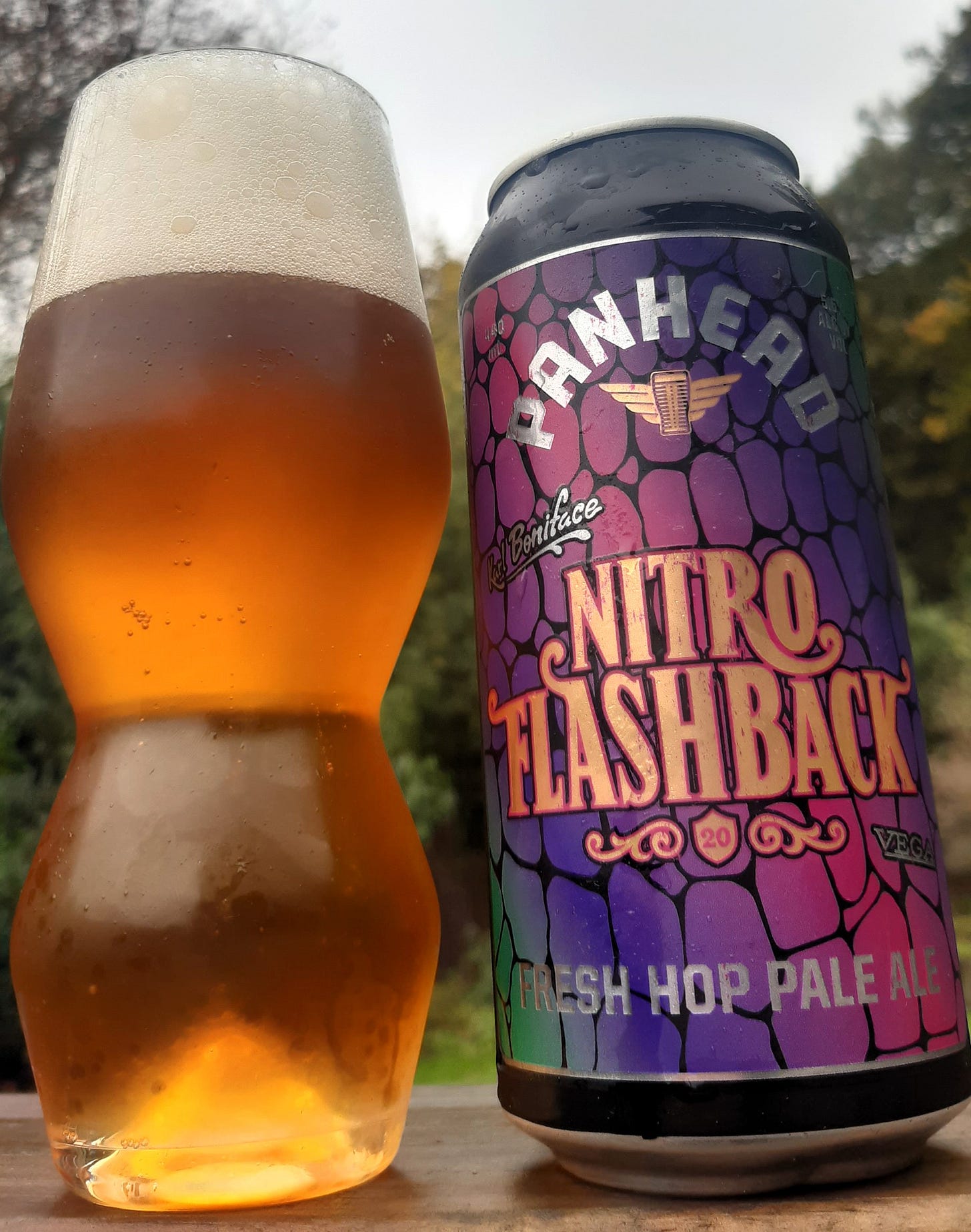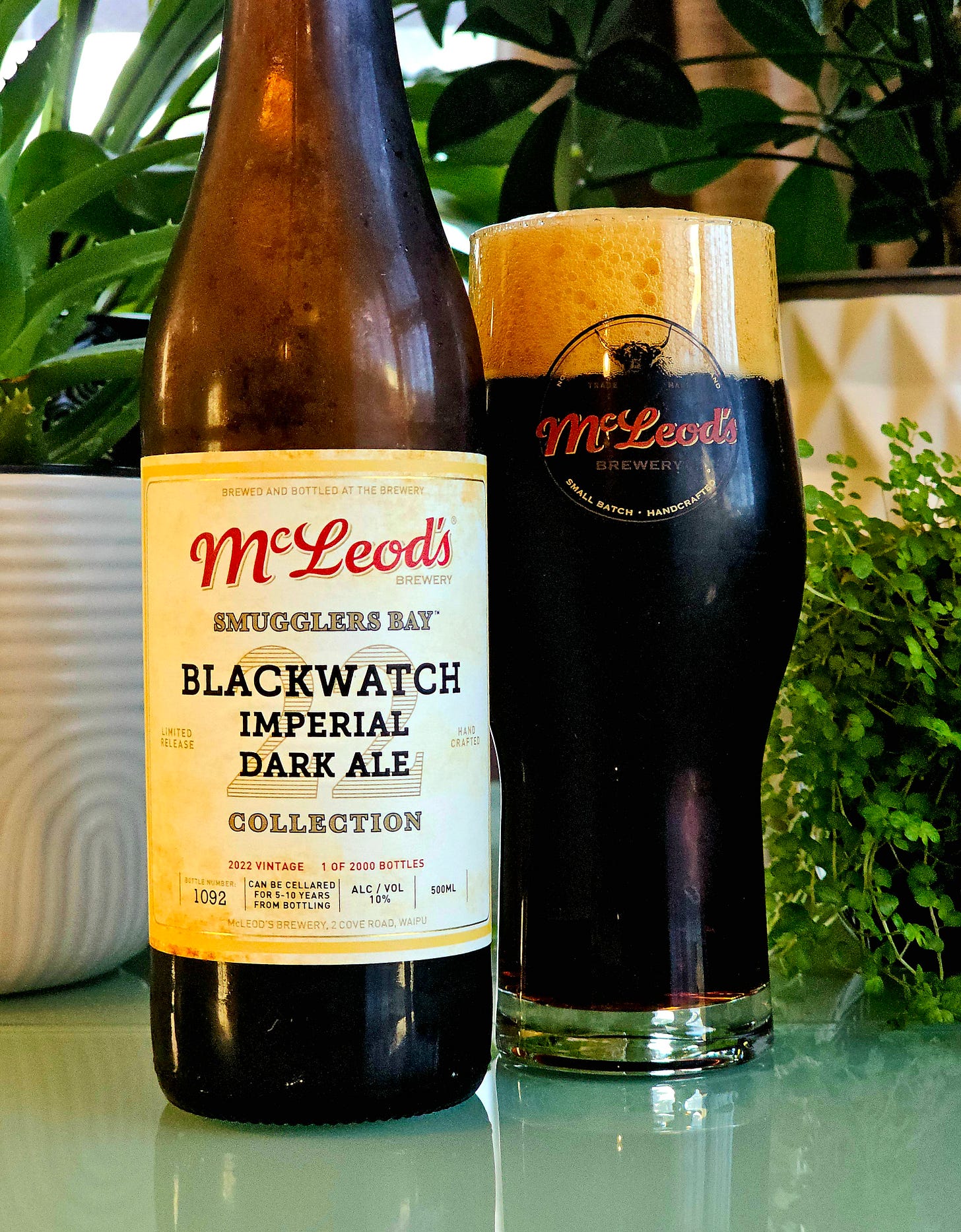What is craft beer's future post-pandemic
A fall from great heights for two once-mighty breweries. Over-rated and under-rated hops. The best temperature to drink beer. An iconic fresh hop beer.
Hey friends, welcome to Friday Night Beers!
First up, if this dispatch comes in lighter than the usual missive — it’s been a full-on week with a bunch of deadlines, plus unpacking a new house, getting the cat-door put in, hooking up the utilities … you know how it goes.
Also, I packed and unpacked roughly 14 dozen cans and bottles of beer. Lord knows how I accrued so many over time!
What’s next for beer?
Late last year I spent more than hour talking to Grant Caunter, from State of Play, the fast-growing non-alcoholic brand.
Grant piqued my interest with text where he used of the phrase Craft 3.0 as a descriptor for the next iteration of craft, the post-pandemic version if you like.
Grant’s view is that craft beer had two major springboards in the past 30-odd years — the stock market crash of the late-1980s and the great financial crisis (GFC) of 2008.
I recently spoke to Jos Ruffell of Garage Project about Swifty and in the course of that conversation, we talked about the post-GFC scene in Wellington when start-ups like Garage Project, Parrotdog, Yeastie Boys and Panhead all came on the scene.
Grant has seen a lot of changes in beer since he started with DB down in Christchurch in the 1990s — and has plenty of insights from his time as head of craft for Heineken in Europe.
He doesn’t have all the answers, but he’s asking some great questions.
Beer of the Week No 1
There’s been a lot of hype about Brave Brewing’s Helping Hands. My colleague Dusty is already calling it a contender for “beer of the year” — let alone the best fresh hop.
An imperial pilsner (6% ABV) and stuffed full of fresh Riwaka, this is an iconic representation of hop harvest. Riwaka and pilsner are made for each other, and I think the bumped-up ABV helps with the density of flavour as this is practically a modern IPA.
This brings all the goodness you want in this kind of beer — cannabis, diesel, grapefruit, grass — and marries that wheelbarrow load of flavours with a slick, resinous mouthfeel and just-right carbonation.
And I know that Brave Brewing have to work extra hard to get the hops to Hastings in the best possible state and the effort that’s gone into this beer is reflected in the exceptional quality.
Over- and under-rated hops
The team at online magazine Vine Pair are always canvassing brewers for their best-and-worst opinions about a variety of things — in this case hops.
In some ways it’s no surprise to see generic “NZ hops” as over-rated by one brewer but that opinion is based on the fact they are being used a lot in America right now. So, it’s more a contrarian view than anything else.
But what I did enjoy reading was the fact that Motueka hops are under-rated, and I couldn’t agree more. Even here in New Zealand, we talk lots about Riwaka, Nelson Sauvin and Nectaron, and for good reason, but Motueka often gets overlooked.
Possibly it’s because it’s such a complementary hop, a support act rather than a star. Plenty of brewers tell me that Motueka is the hop that you add to make everything better — like adding salt to your cooking, it just elevates flavours.
The fact that the Plant & Food hop research team use Motueka as their go-to base hop when trialling potential new varieties tells you a lot about its quality.
Last year I talked to Jude La Rose, co-founder of Chicago’s Hop Butcher, and an unabashed fan of Motueka.
He says Motueka works in every style of beer and makes every beer better.
“Nothing can deliver a true lemon and line character like Motueka can,” he told me.
“If you were to make a beer and feature just one hop that can entirely carry the character of the beer … Motueka can do that. But if you’re looking to add some complexity or edge, or another kind of ‘colour’ to the aroma-flavour palette, Motueka can do that — it has no problem taking a back seat and brightening up or augmenting whatever is around it.”
La Rose talks about hop flavours in colours, describing Citra, for example as “orange and yellow”.
“Citra is undeniably a great hop and is unmistakable. It produces these big orange and yellow flavour-colours – if you wanted to add more yellow and green to that mix, there’s no other hop but Motueka to do that. It adds this top note — like the treble in music — of lemon and lime that sings a little bit higher.”
He also loves the creamy tang that Motueka can add, making it a great hop in wheat beers.
“I think that there is a common thread all New Zealand hops are tethered to – that a wild sense of New Zealand terroir, of grassiness, of earth-driven flavour and aromatics. Motueka has that plus a vanilla, creamy character to it, almost a Greek yoghurt type of flavour.”
How the might have fallen No 1
The Matilda Bay brewery — in its first incarnation in Western Australia — was formative in the lives of so many Kiwis (hello Redback!) — not least because it was a young Richard Emerson’s first brewery job as he set off on a world trip that culminated in him opening Emerson’s in 1992.
The WA branch of Matilda Bay closed a few year back and now Asahi Beverages has announced it will be closing Matilda Bay's brewpub in Healesville, Victoria, this month — less than five years after the pioneering brewery was revived by the major brewer and its founder, Phil Sexton.
Ryan Saundry, general manager of Fire & Earth Ventures (the craft arm of Asahi/CUB), told The Crafty Pint in an emailed statement that, while they had enjoyed some success with innovation at the Matilda Bay brewpub, they'd made the "difficult decision" to close the doors and cease manufacturing there.
"We want to express our thanks and gratitude to our Matilda Bay team who have helped us expand the brand over the last few years, including through the very challenging Covid-19 period when we first launched the brewpub," he said.
Asahi said the closure would impact existing team members but they were supporting those impacted and actively exploring other roles within the business. They added that, while the venue would close, Matilda Bay beers will continue to be brewed at other CUB sites, including Pirate Life in Port Adelaide.
Matilda Bay is considered one of Australia’s first craft brands, having started in the early 1980s. Over the years, the likes of Redback, Dogbolter and one of Australia's earliest hop-forward pales, Alpha Pale Ale, became part of the country's beer folklore.
Tim’s Beer of the Week
The last few weeks I’ve featured big, full-strength IPAs for my fresh hop picks, but for those looking for something a little less intense (or at least less alcoholic!) I can recommend Panhead’s Nitro Flashback (5.5%) fresh hopped pale ale. A distinct aroma of tangerine and orange creates a seriously juicy nose that holds tight to its pithy citrus focus. It’s similarly lively on the palate with a great acidic lift, smooth malt backbone, and a lower bitterness that really puts the focus on the fruity hop notes. This could easily contend with a hazy for sheer juice factor. — Tim Newman
And just remember, if you’re looking for fresh hop beer, or great beer in general, check out your local New World, your home of craft beer.
The perfect temperature for beer
This story has been doing the rounds this week — Scientists discover the perfect temperature to drink your beer | Stuff — and spoiler alert, it’s roughly your fridge temperature!
But there’s more to the analysis than that, and it’s a good science-y read, but it seems to me they’re only considering one style of beer, most likely lager.
One of the reasons I’m a big of 440ml cans (and 500ml bottles) is the time it takes to drink them, and the fact the beer can warm up slightly as you progress through the glass. There’s something perfect about those first few sips at fridge temp, but there’s an equally enjoyable experience that comes with the expanding flavours (especially in hoppy beers) that evolve as the beer warms up slightly.
The talk of optimal temperatures does remind of an incident in my former life as a cricket journalist. We were in India with the Australian cricket team, and it was hot. Back then the Aussies were sponsored by Fosters and there was always a few tinnies available at the end of the day. The only problem was getting them cold enough.
At one hotel, a colleague gave a case of beer to one of the hotel staff around lunch time and asked for them to be chilled. When the beers turned up later in the day they were probably 8-10C and Malcolm demanded they get put in the freezer and barked: “don’t bring them back until they are freezing!”
Perhaps it was the only way to enjoy Fosters — so cold you can’t taste anything!
Beer of the Week No 2
I’ve been remiss not to post this sooner, but amidst all the fresh hops it slipped off my radar from a couple of weeks back. So I hope Flamingo Bingo is still available (update: just checked on Three Sisters website and they have 12 left!).
Anyway, why I love this is that it’s one of the few Cryo-hopped beers that has really worked for me. Often I find them a little one-dimensional and lacking some tension because all the astringency has been removed. Here Three Sisters have used Cryo Mosaic and Cryo Citra with some Citra T90.
Froth Tech Spectra yeast and wheat malt add to the flavour profile, which is excellent (I get mango and sweet basil … for some reason Mosaic give me that perception). But it’s the texture of this beer that I loved so much — seamless and silky.
How the mighty have fallen No 2
Ballast Point was once the absolute star of American craft beer, sold to Constellation Brands for $1bn in 2015 when big breweries were going nuts for the next big thing.
Four years later Ballast Point was dumped by Constellation and picked up by Kings & Convicts for an undisclosed sum.
And now, the ultimate humiliation: Kings & Convicts are closing the San Diego brewery and Ballast Point will now be contract brewed.
Kings & Convicts Brewing CEO Brendan Watters said the brewery was just now too big for the small Ballast Point production. Once it had operating around the clock to meet demand.
“It’s been a hard week, but we had to right the ship,” Watters told San Diego Beer News. “I’ve been trying to get us out of there for the better part of a year-and-a-half. We brought other breweries in [on a contract-brewing basis] to try to fill it up. It’s too big, and that ain’t Ballast Point.”
Kings & Convicts said it had planned to reinvigorate the Ballast Point brand, but the pandemic meant those ambitions went unrealised.
They do hope to find a new, smaller home for Ballast Point and return it to its glory days.
“We’ve signed a contract with another company that will take over the Miramar brewery. In the short-term, we will be working with them on a contract basis to fulfill our taprooms and distribution while we try to acquire or build another San Diego facility, ideally with an 80-to-100-barrel brewhouse. That will allow us to crank things out and make money from them,” says Watters. “We want to bring Ballast Point back to what it is, a premium brand on the West Coast.”
Dusty’s Beer of the Week
Embracing the autumnal vibes with McLeod’s Blackwatch — a 10% imperial black ale from the Smugglers Bay collection of 2022. Pours midnight black with a marshmallowy head, immediate notes of espresso & dark chocolate which follow through on the mouthfeel providing sweet tart earthy layerings. There’s additional sweet caramel further in with fleeting booze hits, the finish is viscous and roasty — an absolute treasure of a beer and cannot recommend this highly enough.
The rise and rise of Guinness 0.0
Self-styled Guinness Guru, Daragh Curran once said you’d be “mad” to have a non-alcoholic drink in the pub.
But after three years and many failed attempts to enjoy a Guinness 0.0 he’s finally conceded they’ve got it right.
“I was in Mulligan’s in Poolbeg, which does a stellar pint of normal Guinness, and the bartender said it [0.0] was going well and to give it a shot,” he said.
“I tried it, and I was very much surprised; I thought they had really turned it around since the launch of the first keg and it was now a decent product.”
Curran was speaking as Diageo released data showing sales of Guinness 0.0 have increased by 50% over the last year in Ireland.
Part of that is riding the recent success of full-strength Guinness, and the other part is driven by the increasing number of people taking the non-alc route.
This winter I fully expect someone in New Zealand to release a non-alcoholic stout — and I’ll be there for it.
By the way, Guinness has reportedly done a £41 million deal to back the English Premier League over the next four years — a massive financial uptick on the Premier League's existing partnership with Budweiser.
Guinness has historically been more closely associated with promoting itself through an association with rugby union than football.
Beer of the Week No 3
Was out to dinner the other week — my wife and I had our first date at a Sydney restaurant called Oh Calcutta, so when we moved to Auckland and discovered Oh Calcutta in Parnell, it became a regular “anniversary” spot.
And what better beer to have with a great curry than Emerson’s Pilsner. It doesn’t taste like it used to, I’ll admit that — it’s more floral than passionfruit — but it’s exceptionally dry and so well-balanced and remains a mighty fine pilsner: clean, fresh and snappy!
Happy days!
That’s it from me, catch you again next week.














I think it’s cool that there’s so much Guinness 0.0 in keg… hardly anyone daring to do it here with non alcs. Been 10 years since my last visit to Ireland and well overdue… where have you been? I love Galway and Donegal.
Been in Ireland for the past few weeks and I can confirm Guinness 0.0 is very good. They even have a special machine (similar to the nitro serve technology) to pour it from the can in a pub which probably ensures consistency/ freshness. Unfortunately the craft beer scene hasn’t significantly moved on here since my last trip about 5 years ago.